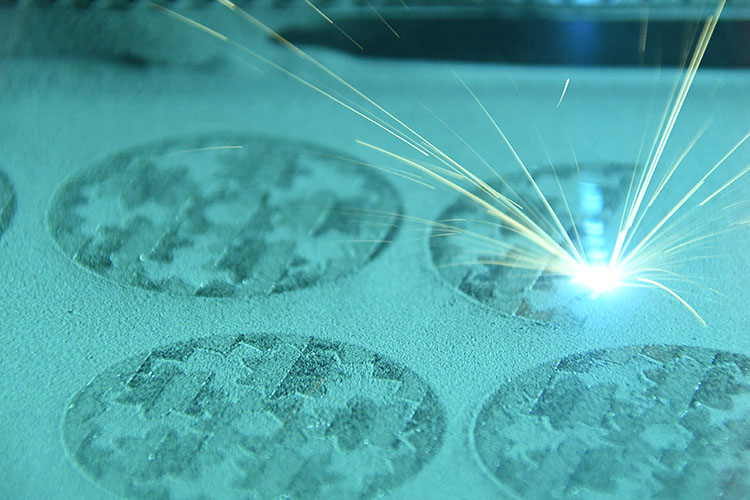Additive manufacturing for low-cost sustainment
 America Makes awards $8 million to UDRI for additive manufacturing R&D to support Air Force efforts toward safe, more efficient sustainment
America Makes awards $8 million to UDRI for additive manufacturing R&D to support Air Force efforts toward safe, more efficient sustainment
The University of Dayton Research Institute has been awarded $8 million from America Makes, the National Additive Manufacturing Innovation Institute, to lead a national program that will use additive manufacturing to help the Air Force more efficiently and affordably sustain aging aircraft. Funding for the award was provided by the Air Force Research Laboratory, and directed to UDRI by America Makes under a new cooperative agreement between America Makes and AFRL.
UDRI will partner and share the award with Youngstown State University to lead a 25-member program team comprising representatives of academia, industry and the Air Force. This supply chain of university researchers; original equipment manufacturers, including GE, Boeing, Honeywell, Lockheed Martin and Raytheon; small-business manufacturers and other partners, will work to design, develop and demonstrate new technologies in additive manufacturing and related advanced manufacturing techniques, and then transition those technologies to the Air Force’s three air logistics complexes located at Robins Air Force Base in Georgia, Hill Air Force Base in Utah, and Tinker Air Force Base in Oklahoma.
The goal of the program is to help the Air Force improve fleet readiness and availability, and reduce the amount of time aircraft are out of service for maintenance and repair, said program manager Brian Rice, head of UDRI’s Multi-Scale Composites & Polymers division. The challenge lies in finding replacement parts for an aging fleet, whose planes are flying well beyond their planned service lives, Rice added.
“One of the biggest hurdles to maintaining legacy aircraft is securing out-of-production spare parts,” Rice said. “In some cases, suppliers have gone out of business, or they will no longer support the production of spare parts for older aircraft. It’s just not profitable for them. In other cases tooling is gone, and the cost of making new tooling is prohibitively expensive for only low-volume production.”
Rice said the answer lies in additive manufacturing – commonly known as 3D printing – which uses a computer-driven printer to deposit successive layers of polymer, metal or other media – from the bottom up – to create simple or complicated and intricate objects, as dictated by a three-dimensional, digital design file of the object. Additive manufacturing can be used to print actual spare parts as needed, or it can be used to create even very large tooling and molds to be used in traditional forms of manufacturing.
Because older aircraft parts were designed with two-dimensional drawings, before the advent of computer-aided design, digital files for legacy components don’t exist, Rice said. But UDRI researchers have already identified and demonstrated a commercially available technology that will scan a legacy part to generate the three-dimensional digital file needed to print the part using additive manufacturing.
On a small scale, using additive manufacturing for rapid part replacement can be expensive. But the broad-scale, comprehensive nature of the new program – designed to be implemented on a wide level – represents a very cost effective approach to sustainment, Rice said.
“UDRI and Youngstown bring to the program a great deal of expertise in composites- and metals-based additive manufacturing technologies development. Together with our program partners, who collectively represent a powerhouse of advanced and additive manufacturing expertise and product support capabilities, we will provide a wide range of services that will enable the Air Force ALCs to accelerate the adoption of additive manufacturing in their sustainment efforts.”
Under the program, researchers and partners will assess sustainment needs within the Air Force, benchmark best practices, identify and recommend the most promising existing and emerging technologies, provide training to those who will use them and establish a vendor base of qualified suppliers.
“We know what additive can and cannot do, and we’ll be able to go into the depots, assess their needs, and make recommendations for where additive manufacturing makes the most sense,” Rice said. “UDRI has more than 50 years’ experience in supporting aging aircraft and transitioning new technologies to the Air Force, so we are well positioned to do this within the scope of this new program as well.”
America Makes Deputy Director of Technology Development John Wilczynski said the new program “represents the largest additive manufacturing focused effort on sustainment, maintenance and repair technologies ever organized to date.”
“Maintaining its fleet in a cost-efficient manner, using advanced manufacturing technologies – including additive manufacturing – is critical to the strategic readiness of the Air Force today and into the future,” Wilczynski said. “Through its outlined approach, combined with the diverse project team assembled and led by UDRI, a research leader in its own right, America Makes is highly optimistic that the resulting outcome will successfully address the Air Force’s sustainment needs and possibly extend beyond the Air Force to other military branches.”
Rice predicts advances in additive manufacturing technologies will ultimately benefit the automotive and a number of other industries as well.
July 15, 2016
